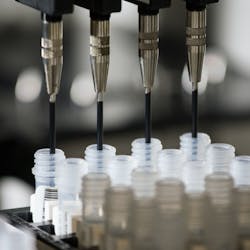A laboratory in a cutting-edge field like molecular infectious-disease testing merits an exceptional quality control program to strengthen confidence in laboratory performance and support optimal patient care. However, molecular diagnostics is not as established as other diagnostics segments, and the corresponding QC standards and regulations are not as well-defined. The rapid innovation and evolving regulations around molecular testing can make it difficult to create and maintain an effective QC program, accounting for quality, efficiency, and regulatory requirements.
This article highlights relevant QC considerations for molecular diagnostics and presents effective QC solutions and best practices to support dynamic and evolving molecular laboratories.
Improving laboratory performance with effective QC practices
Systematic quality control is a laboratory’s first line of defense against potentially disastrous consequences. This is especially true for clinical laboratories because results directly impact patient treatment. Additionally, any change in the test system or process (e.g., new reagent lots, new instruments, etc.) could potentially affect the quality and integrity of the results. Procedural errors, instrument malfunctions, environmental changes and any other variables can also alter test results. While some of the resulting effects are obvious, other changes are subtle and only detectable with a methodical quality control analysis.
By adhering to thorough QC procedures, molecular laboratories can closely monitor testing for both random and systematic errors, as well as immediate data shifts and abnormal long-term trends. The early detection of anomalies allows laboratories to address issues promptly, before they adversely impact patient data.
A standard QC program might only rely on in-kit controls and proficiency surveys. As discussed below, supplementing this with independent third-party controls, as well as a QC data management software, considerably strengthens QC measures, while mitigating any bias that may result from in-kit materials. A rigorous QC program not only helps fulfill regulatory requirements, but it also increases result confidence, enhances efficiency, minimizes budgetary waste, and simplifies laboratory procedures.
Streamlining QC with data management software
Integrating data management software into molecular laboratories is a transformative step in modernizing, simplifying, and strengthening laboratory procedures. Following a rigorous quality control program is critical, especially when dealing with patient specimens. It can be challenging to prioritize quality while focusing on saving time, complying with regulations, and minimizing expenses. Automating data management is the solution to greatly simplify this QC process.
Challenges with molecular QC data management
Many molecular laboratories spend hours manually entering and analyzing QC data in spreadsheets or basic software programs. In addition to taking up valuable time better spent elsewhere, the process of manually recording data is tedious and substantially error-prone.
Effective QC analysis should take into account QC results over time and compare them to other laboratories (peer groups). Performing this level of analysis by manually gathering and entering outside data from detailed spreadsheets after sourcing it is challenging and causes delays in noticing errors and variations in the data. Time is everything in a clinical laboratory: the longer it takes to identify errors, the more patient results could be affected.
As molecular diagnostics expands within and across laboratories, the amount of QC data to be collected rises, making the analysis of higher volumes of data more complex.
Supporting molecular laboratories with QC data management software
Effective QC data management software programs automate all the steps of a QC data system, from collection to analysis. Data can flow directly from instruments and laboratory information systems (LIS) to QC data management software, eliminating the undesirable manual data recording step. This generates a reliable, accurate and standardized database of results. Laboratories can monitor data in real-time as it is transmitted to the software. Consequently, meaningful errors that might otherwise go unnoticed can be promptly identified and resolved. In molecular infectious disease testing, this can be accomplished by monitoring cycle threshold values, for example. Statistical capabilities of the software can conduct a comprehensive QC analysis, including bias and imprecision calculations, alerting the user of shifts that may need immediate attention, while monitoring values over time to identify subtle trends that could affect the overall laboratory performance. When changes in lots (reagents or standards), operators, the environment, and instrument maintenance occur, the software will identify any resulting shifts or concerning trends.
A powerful QC data management software platform should also provide access to data from peer groups, an invaluable resource to compare testing performance (snapshot and long-term trends) across molecular laboratories. This tool is not only a good preparation for proficiency testing, but also helps identify problem areas while assisting with troubleshooting efforts.
The automation of QC documentation and analysis is another source for time-saving that also offers the advantage of presenting the information needed to monitor quality efficiently. It makes regulation compliance straightforward by easily printing detailed QC reports for auditors, rather than spending time compiling data manually from spreadsheets.
Every feature of powerful QC data management software helps molecular laboratories take control of their QC and develop comprehensive awareness of their performance strengths and weaknesses. A QC program monitored by powerful data management and analysis tools helps save time and cost while increasing confidence in results.
Evaluating assay performance with independent control materials
Independent quality control materials bring molecular infectious disease testing to the level of standardization and uniformity needed in clinical testing.
A QC program is only as effective as its controls. If QC materials do not perform as expected, potentially harmful errors could go unnoticed. Even careful data analysis cannot identify anomalies if not accurately represented by the data.
It is critical that controls closely mimic patient specimens by consisting of whole inactivated pathogens diluted in the relevant clinical matrix. This allows those controls to capture inconsistencies and changes in a similar manner to patient specimens.
Many controls are made of synthetic materials diluted in matrices unrelated to patient specimens (although whole organisms may be available). Moreover, in-kit controls are optimized to function with specific assay platforms and reagents. Indeed, assay reagents are developed and tested by assay manufacturers with the same materials making up the controls provided in their kits, hence introducing a potential prejudicial bias. Additionally, when assays also include standards, the in-kit control(s) typically derive from those standards. Therefore, if an issue impacts the standards, the in-kit controls are affected in the very same manner, making everything appear as normal, while the underlying issue may continue to impact patient results. Hence, it is critical to use well designed, independent, and unbiased third-party QC controls in addition to (or instead of) the in-kit controls. Such independent molecular controls are designed to mimic clinical specimens and consist of whole inactivated pathogens in relevant clinical matrices, so they are affected by the entire analytical process in the exact same manner as the same pathogens found in the patient specimens. Hence, unlike with synthetic controls, each of the extraction, amplification and detection steps is fully controlled in an unbiased and thorough manner.
If the independent controls and standards are not rigorously manufactured, they could also introduce a drift in the QC data. Hence, their manufacturing should rely on ddPCR (droplet digital PCR) to ensure their absolute quantification whether they are assayed or unassayed. This helps to maintain every lot of those independent controls and standards within a tight range of acceptance criteria. This is particularly important for standards and controls of molecular quantitative assays.
Supplementing a QC program with independently manufactured controls allows an unbiased, comprehensive, and rigorous analysis of instrument and assay performance, while minimizing inventory waste, since their usage is not restricted to a single lot of assay reagents.
Investing in laboratory excellence
A comprehensive QC program is a form of risk mitigation. Like an insurance policy, it provides an extra layer of security, protecting from possible complications and mistakes. Effective QC programs limit the risks of potential harm to patients, liability of the laboratory, economic consequences, and damage to a laboratory’s reputation.
Clinical laboratories are constantly under pressure to increase efficiency and lower spending. While independent controls and QC software may seem to be an added expense on the surface, a limited QC program may ultimately cost a laboratory much more than that investment. Money not spent up front on problem detection and prevention can result in much higher failure costs in the long run. Quality should not be sacrificed for price. For example, controls made of synthetic materials and/or in-kit controls optimized for specific instruments or reagents may not be attuned to nuanced variations in patient specimens.
In summary, investing in a comprehensive quality control program lowers the risk of inconsistent and inaccurate results that if allowed to leave the laboratory could result in expensive retesting or lead to misdiagnosis. An effective QC program avoids potentially severe consequences by capturing mistakes before any incorrect results are reported. Because a testing laboratory’s first priority is its patients, adopting rigorous quality control measures is an investment in a higher standard of patient care. Supplementing a laboratory’s QC program with independent third-party QC controls and QC data management software demonstrates the laboratory’s dedication to exceptional patient care, economic efficiency and forward-thinking.
The authors acknowledge the contributions of Sarah Lehman for this article.




